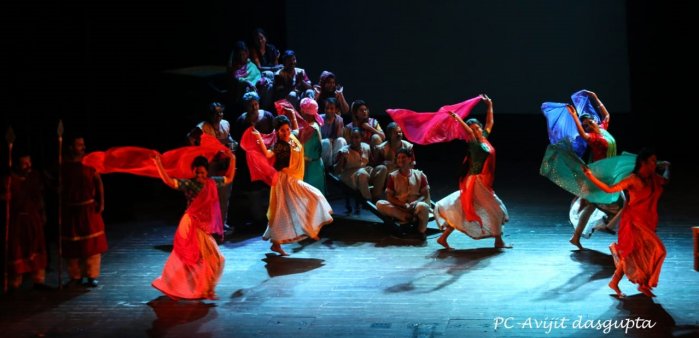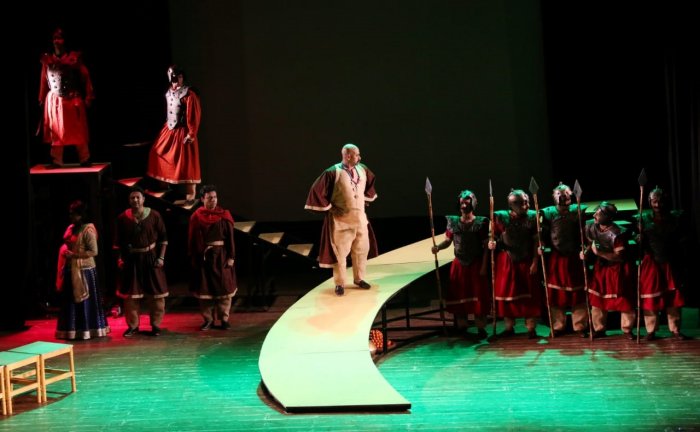
|   |

|   |
 e-mail: ukb7@rediffmail.com Unrequited Love, Unrelenting bigotry February 18, 2019 Nasika Puran Cyrano de Bergerac, the famous 1897 play by the dramatist-poet Edmond Rostand, is cast in the mould of the proverbial parable of 'Beauty and the Beast', except that the Beast here uses the vision of a handsome, yet dumb male upfront - as a friend to support -- to entice the incurably romantically-minded Beauty through recitations and verses. Only at the very end, the Beauty realises that the Beast was her destined lover, Cyrano. Rostand's memorable dialogue alludes to the final recognition: The Beauty says: I love you. And the Beast's ugliness falls like a magic veil... The widely-performed French play -- credited with a Cyrano played on celluloid by the legendary hero Gerard Depardieu - was known to have been broadly modelled on a real-life noble man Cyrano de Bergerac, a 17th century elegant poet and philosopher, yet thoroughly spoilt and licentious, but Rostand play's fictionalisation elevates itself to a superb ménage a trois. Cyrano, a cadet (nobleman serving as a soldier) in the French Army, is a brash, strong-willed man of many talents. In addition to being a remarkable duellist, he is a gifted, delightful poet and is also a musician. He has, however, an inordinately long nose, which causes him to intensive bouts of self-doubt. This hesitation prevents him from expressing his love for his distant cousin, the beautiful and intellectual Roxanne, as he believes that his ugliness would prevent him the "dream of being loved by even an ugly woman." Till his last breath, Cyrano retains his panache, his typical flamboyance of self-negating style that he gifts to his society and to literature.   Nasika Puran (The Saga of Nose), presented on January 25 by Minerva Repertory Theatre, was a Bengali adaptation by the astute thespian Ashok Mukherjee, with a locale in 7th century Bengal at the historical time of Shashanka Deva, with wars and turmoil of the period. Directed by the emerging thespian Biplab Banerjee, the play faithfully follows the original storyline: the noisy introduction of the multiple dramatis personae; the festive scenes during a royal coronation; the song-and-dance interludes of the drama about to be staged for the nonce; the very athletic Cadet descending acrobatically from an overhanging rope (and also performing his last act of bravado from the rope); and the generally confused battle scenes played out with blast and thunder. The second half virtually takes off flyingly on the love triangle with suspenseful acting and confrontations among the rivals. A fourth love interest - also there in the Rostand original - is the bumptious commander pursuing the pretty princess and generally making a mess of things. The fifth act - the temple monastery of the celibate women where the dejected princess now lives as a widowed recluse - is poignantly crafted, with the final denouement well enacted. In fact, it did seem that the first half was somewhat symptomatic of a cluttered up melee of characters, capable of some editing. The set design and lighting was of top quality and the youthful Repertory actors rose very well to their acting ambitions. Lal Salu Syed Waliullah (1922 - 1971) was a Bangladeshi novelist, short-story writer and playwright, whose 1948 award-winning debut novel, Lal Salu (translated by the author, calling his English version as 'Tree without Roots'), castigated fundamentalism and religious bigotry in Islam - as perpetuated by orthodox self-seekers - with whiplash sarcasm. Made into a memorable film, Lal Salu -- by Bangladesh's prime cineaste, Tanvil Mokammel -- went on to win many laurels. The novel essentially tells the story of Majid, an indigent pseudo-cleric from a devout Muslim background, who arrives at a remote village and shrewdly declares an old derelict grave to be the Majaar (graveyard) of a Peer (saint), covers it with the traditional red cloth used for mausoleums, and establishes his stronghold on the life of the simple, god-fearing people using the reflected power on him of the supposed saint. The novel shows his ascent to power and social prosperity, struggle with other religious figures trying to establish dominance, the undercurrent of pagan ideas among the people, and finally his own weaknesses that exposes him at the end. Lal Salu (Ceremonial Red Cloth), performed on February 8 by 'Prachya', was a love's labour bringing out the full range of practices and rituals that are called upon to fool the believing masses in any religion. Spearheaded by the talented director Abanti Chakraborty, the powerful play builds up - brick by brick - the marginalised village community who are hardly very religious, let alone communal, and believe in earning their daily bread through back-breaking toil and hard labour. Such a milieu is ideally suited for exploitation to Majid Mian, the cunning, power-seeking religious bigot, who is bent upon establishing himself as a Peer. 

According to a noted Muslim critic, the worship of burial grounds and Majaars are prohibited in the Quran, as well as the honouring of any Peer. The easily gullible folks, nonetheless, accept the powerful oration of Majid, supported consistently by his faithful wife, a widow whom he had married in the village. Resistance comes unexpectedly from Jamila -- the childless wife of Khalek, a wealthy simple-minded businessman in the village -- against whom Majid works out a case for Tin Talaq by her husband. Jamila revolts, by contemptuously placing her foot on the Majaar, thereby symbolising the subversion of Majid's elaborate plot of establishing the regime of fundamentalism. In many senses, Lal Salu is a departure from the common, run-of-the-mill protest play. It not merely emphatically rejects the familiar format of the West, it also builds itself on a completely indigenous sensibility, primarily based on folk music and rurally relevant choreography. Also, in the pervading milieu of the usual narratives of the Hindu mindset, it courageously tackles many issues intimately concerning the Muslim society; like circumcision, triple divorce and child marriage by over-the-top, aged wealthy men. And due credit must be given to Biplab Banerjee, who brilliantly personifies the central character of Majid, with all its nuances and mannerisms, complete with his physical acting and verbalising the village lingo. A memorable experience, on the whole.  Dr. Utpal K Banerjee is a scholar-commentator on performing arts over last four decades. He has authored 23 books on Indian art and culture, and 10 on Tagore studies. He served IGNCA as National Project Director, was a Tagore Research Scholar and is recipient of Padma Shri. Post your comments Please provide your name and email id when you use the Anonymous profile in the blog to post a comment. All appropriate comments posted with name & email id in the blog will also be featured in the site. |